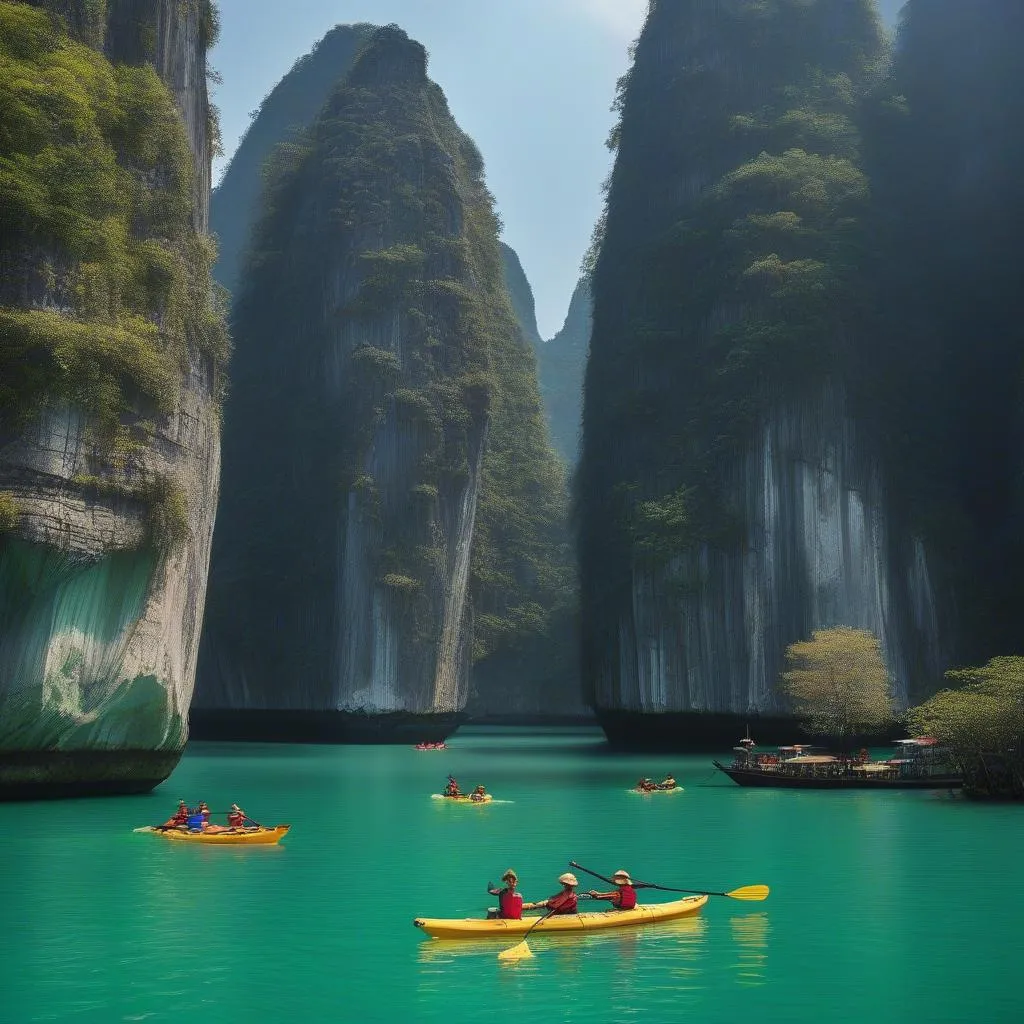Have you ever dreamt of escaping the daily grind and finding solace in nature’s embrace? Imagine a place where lush greenery meets crystal-clear waters, where the air hums with the sounds of exotic birds, and where every step you take leads you closer to serenity. This is the allure of ecotourism, a booming industry that promises travelers authentic and sustainable experiences. But what does it take to open an ecotourism destination that not only captivates visitors but also preserves the very environment that draws them in?
Understanding Ecotourism: More Than Just a Buzzword
Ecotourism, often dubbed “responsible travel,” goes beyond simply offering nature-based adventures. It’s about immersing travelers in the local environment, culture, and community while minimizing negative impacts and fostering conservation efforts. Think exploring the breathtaking rice terraces of Sapa, Vietnam, while learning about traditional farming practices from local villagers. Or embarking on a jungle trek through Taman Negara National Park in Malaysia, guided by indigenous communities who call this biodiversity hotspot home.
Professor Nguyen Thi Lan Anh, author of “Sustainable Tourism in Southeast Asia,” emphasizes, “Successful ecotourism hinges on creating a symbiotic relationship between travelers, local communities, and the environment.”
Building Your Ecotourism Dream: A Step-by-Step Guide
So, you’re ready to turn your passion for nature into a thriving ecotourism venture? Here’s a roadmap to guide you:
1. Location, Location, Location…and Sustainability
Choosing the Right Spot:
- Natural Assets: Do you envision a serene beach retreat, a thrilling mountain adventure, or an immersive rainforest experience? Your location should boast unique natural features that appeal to your target audience. Imagine offering guided kayaking tours through the mystical Ha Long Bay in Vietnam, or thrilling hikes to the peak of Fansipan, the “Rooftop of Indochina.”
- Cultural Richness: Ecotourism thrives on authenticity. Look for locations with vibrant local cultures, traditions, and crafts. Consider offering cooking classes featuring regional specialties near Hoi An’s ancient town or weaving workshops in the highlands of Sapa.
- Accessibility: While remoteness can be alluring, ensure your chosen location is accessible to visitors while minimizing environmental impact. This might involve investing in eco-friendly transportation options or partnering with local communities to develop sustainable infrastructure.
Sustainability from the Ground Up:
- Environmental Impact Assessment: Before breaking ground, conduct a thorough assessment to identify potential environmental impacts and develop mitigation strategies. This might involve minimizing waste, conserving water and energy, and protecting local flora and fauna.
- Community Engagement: Involve local communities from the outset. Consult with residents, understand their needs, and ensure your venture benefits them economically and socially. This could involve creating employment opportunities, sourcing local goods and services, or supporting community-led initiatives.
2. Crafting Unforgettable Experiences
Experiences that Resonate:
- Authenticity is Key: Offer experiences that provide genuine insights into the local culture, history, and environment. Imagine a traditional fishing trip with local fishermen in the Mekong Delta or a guided meditation session led by Buddhist monks in a serene temple setting.
- Diversity is Spice: Cater to a range of interests and fitness levels. Provide options for adventure enthusiasts, nature lovers, and those seeking relaxation and wellness. This could range from challenging hikes and wildlife safaris to leisurely nature walks and birdwatching tours.
- Interpretation and Education: Go beyond simply showcasing natural beauty; educate your guests about the local ecosystem, conservation efforts, and cultural heritage. Consider partnering with local experts or offering interactive workshops and presentations.
Responsible Operations:
- Waste Management: Implement effective waste management systems, including composting, recycling, and responsible disposal. Encourage guests to minimize their footprint by providing reusable water bottles and reducing single-use plastics.
- Water Conservation: Conserve water through low-flow fixtures, rainwater harvesting, and water-efficient landscaping. Educate guests about water conservation practices.
- Energy Efficiency: Embrace renewable energy sources like solar power. Implement energy-efficient lighting and appliances.
** Kayaking Tour in Ha Long Bay**
Kayaking Tour in Ha Long Bay**
3. Marketing Your Ecotourism Paradise
Reaching Your Audience:
- Digital Presence: Create a compelling website showcasing your unique offerings, stunning visuals, and commitment to sustainability. Utilize social media platforms to engage with potential travelers and share captivating stories.
- Partnerships: Collaborate with travel agents, tour operators, and ecotourism platforms to expand your reach.
- Community Engagement: Partner with local businesses and organizations to promote cross-promotion and create a network of support.
Transparency and Authenticity:
- Eco-Certifications: Obtain relevant eco-certifications to demonstrate your commitment to sustainability and build trust with eco-conscious travelers.
- Storytelling: Share your story and your commitment to responsible tourism through compelling blog posts, captivating videos, and engaging social media content.
- Guest Reviews: Encourage satisfied guests to share their experiences through online reviews and testimonials.
Pricing Your Ecotourism Offerings
Finding the Right Balance:
- Value for Money: Ecotourism often commands a premium price due to its focus on sustainability and community benefits. Clearly communicate the value proposition to your guests, highlighting the unique experiences, responsible practices, and positive impact their visit supports.
- Market Research: Research pricing strategies of similar ecotourism ventures in your region. Consider factors such as target audience, seasonality, and package inclusions.
- Transparency: Be transparent about your pricing structure, including any additional fees or contributions to conservation efforts.
Sample Pricing Table:
| Ecotourism Activity | Duration | Price per person |
|---|---|---|
| Guided Jungle Trek | Half-day | $50 |
| Kayaking Tour with Local Guide | Full-day | $80 |
| Birdwatching Excursion | Half-day | $60 |
| Cultural Village Visit & Home-cooked Meal | Half-day | $40 |
Planning Your Ecotourism Adventure
Essential Tips for Travelers:
- Research and Choose Responsibly: Select ecotourism operators with proven sustainability practices, positive community engagement, and a commitment to conservation.
- Pack Light and Eco-friendly: Opt for reusable water bottles, eco-friendly toiletries, and biodegradable sunscreen. Pack light to reduce your carbon footprint during transportation.
- Respect Local Cultures: Dress modestly when visiting religious sites. Learn a few basic phrases in the local language to enhance your interactions with communities.
- Support Local Economies: Purchase souvenirs from local artisans and dine at locally owned restaurants to directly benefit communities.
- Leave No Trace: Practice responsible waste disposal, stay on designated trails, and minimize your impact on the natural environment.
Frequently Asked Questions about Ecotourism
Q: What is the difference between ecotourism and sustainable tourism?
A: While the terms are often used interchangeably, ecotourism typically focuses on nature-based travel with a strong emphasis on conservation and education. Sustainable tourism encompasses a broader approach, encompassing environmental, social, and economic responsibility in all forms of travel.
Q: How can I ensure my travels are truly eco-friendly?
A: Choose eco-certified accommodations and tour operators, minimize your carbon footprint, respect local cultures, support local economies, and leave no trace of your visit.
Q: What are some examples of ecotourism activities?
A: Examples include wildlife safaris, birdwatching tours, trekking and hiking, kayaking and canoeing, cultural village visits, and community-based homestays.
Q: How can I find reputable ecotourism operators?
A: Look for certifications from organizations like the Global Sustainable Tourism Council (GSTC), Rainforest Alliance, or other reputable eco-labeling organizations. Research online reviews and testimonials, and check if the operator is transparent about their sustainability practices.
Q: Can ecotourism benefit local communities?
A: Absolutely! When done right, ecotourism can create employment opportunities, generate income for local communities, preserve cultural traditions, and empower communities to protect their natural resources.
Travelcar.edu.vn: Your Guide to Responsible Adventures
For inspiration and guidance on planning your next eco-friendly adventure, explore the wealth of resources on Travelcar.edu.vn. Discover hidden gems like the serene Bamboo Eco-village or immerse yourself in the rich cultural tapestry of Quan Lan. Embrace the principles of ecotourism, and let your travels leave a positive footprint on the world.
** Rice Terraces in Sapa**
Rice Terraces in Sapa**
Embracing a Sustainable Future
Opening an ecotourism destination is more than a business venture; it’s an opportunity to become a steward of our planet. By embracing sustainability, engaging communities, and offering authentic experiences, we can inspire a new generation of responsible travelers and preserve the beauty of our natural world for generations to come.
What steps will you take to make your next trip more eco-friendly? Share your thoughts in the comments below!